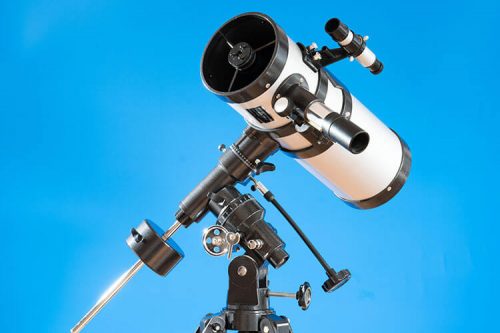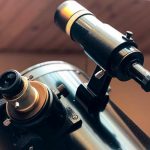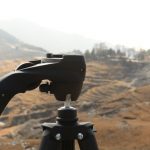Cheshire Eyepiece VS Laser Collimator – Which One Should You Choose?
Owning a Newtonian reflector telescope means collimation, and you may be wondering if you should use a Cheshire Eyepiece or Laser Collimator.
In fact, you can use both or choose to use only one. For the secondary mirror, you would select the Cheshire eyepiece; however, for the primary mirror’s alignment, a Laser collimator is a better tool for the job. Or if you prefer to buy only one of them, you can collimate your mirrors with either device. It really is down to your personal choice and which you like.
This article will give you a good rundown on collimation, and of course, we’ll talk about the Cheshire eyepiece and the Laser collimator, so you have a thorough understanding of how each one works.

Collimation – What Is It?
Anyone new to a Newtonian reflector telescope will have heard about collimation and may worry if it’s as tricky as they’ve read. And if the telescope’s instructions are a bad translation from Chinese, that will only increase your nervousness.
Most collimation guides you will find on Google will not be for a beginner and are full of confusing terminology and details. The problem is they are written more for experienced astronomers than for the beginner.
A reflector telescope consists of three optical elements: the primary mirror, secondary mirror, and the magnifying eyepiece. The eyepiece and the primary mirror are the two active optical elements. The secondary mirror is not active and is only reflective glass.
Collimation is aligning your telescope’s mirrors, so the light they collect is precisely focused. All reflector telescopes work on the same principle: to collect light with the primary mirror, reflect and focus that light onto the secondary mirror.
The secondary mirror will then redirect the light to the eyepiece. To achieve this successfully, the two mirrors, primary and secondary, must precisely align with each other. The secondary mirror must also align precisely with the eyepiece.
If the telescope does not produce crystal clear images or focus correctly on what you’re viewing in the eyepiece, then the mirrors are out of collimation.
Wouldn’t the manufacturer collimate the telescope before shipping it to you? Yes, they would, but sometimes shipping throws out the collimation, or the shipper might have dropped the telescope.
Cheshire Eyepiece Collimator

The Cheshire eyepieces are available in different lengths and look similar to your telescope eyepiece. The Cheshire is the ideal tool to collimate the secondary mirror. When you look through the focuser, the secondary mirror should be entirely in the center and angled to reflect light from the primary mirror.
It’s not necessary to continually be collimating a secondary mirror. Unless you know it will require collimation through rough handling, it should hold its position very well.
Collimating A Telescope With Cheshire Eyepiece
Different telescopes will have different views when you’re collimating with a Cheshire eyepiece. F5 and below will be slightly off-center, but F5 and above will be easier to collimate because the view will be more in the center.
The objective is centering the primary mirror’s reflection in the secondary mirror and the Cheshire’s reflection with the secondary mirror.
There are adjustment screws on both the primary and secondary mirrors, looking through the Cheshire at the same time as adjusting the screws until you achieve the objective.
Cheshire Eyepiece Key Features:
- No batteries are necessary with the Cheshire
- Excellent price point
- Ideal if you are collimating a secondary mirror
- Collimation with the Cheshire only in the daylight
- It’s more challenging to use the Cheshire on longer telescopes
- Can collimate a primary mirror but not ideal
Laser Collimator

When you are aligning the primary and secondary mirrors, you can choose to use a laser collimator. You will find the laser an ideal tool for collimating a primary mirror and the secondary mirror’s angle. If you need to center the secondary mirror in the focuser, please refer to the Cheshire eyepiece’s above section.
We mentioned the secondary mirror doesn’t require that much attention, so use a laser collimator only for the primary mirror.
Collimate A Telescope With A Laser Collimator
The secondary mirror requires centering before using the laser collimator. When that is as it should be, position the laser collimator in the eyepiece holder; switch it on. When you view inside the telescope, you will find the laser beam on the primary mirror. If you find the shaft of light is too bright for you, it can be adjusted to suit your eyes.
There is a small donut in the middle of all primary mirrors. The donut makes centering the laser so much easier. Now all you need to do is ensure the laser beam is precisely in the center of the donut. If you find it isn’t, then there are some adjustable screws on the secondary mirror. The purpose of these adjustments is to correct the angle of the secondary mirror.
You will need to adjust the primary mirror from the rear of the telescope. When adjusting the primary mirror, you need to see a bullseye in the collimator tool. If you can see the laser is off-center, you must adjust with the primary mirror screws, so it’s not visible.
Misalignment Of The Laser Collimator
Amateur astronomers tend to choose the Cheshire eyepiece rather than the laser collimator. If the laser is not aligned correctly with the collimator’s body, then achieving accurate collimation is all but impossible. Rotating the collimator in the focuser, you will notice the beam in the primary mirror keeps moving.
There may be an unnecessary distance between the laser collimator and the eyepiece holder, or the focuser could also be misaligned.
Any quality laser collimators should have adjustment screws. These screws will help calibrate the collimator so that it is aligned correctly.
Laser Collimator Key Features:
- The laser collimator is best for the primary mirror collimation and the secondary mirror angle
- The laser collimator is easy to use
- Because it’s a light beam, there’s no problem with using it at night
- It’s difficult to center the secondary mirror using a laser collimator
- There is also the problem of a laser collimator not aligning correctly
- The collimator requires batteries for it to function
Conclusion
To enable your collimation efforts to be precise enough to view clearly through a reflector telescope, you should have a Cheshire eyepiece and a laser collimator. Once you master the process of collimation, you’ll wonder why you were ever nervous about performing the adjustments.
Even allowing for slight misalignment and the collimation not being absolutely spot on, it shouldn’t prevent you from the enjoyment of viewing the sky at night.


















